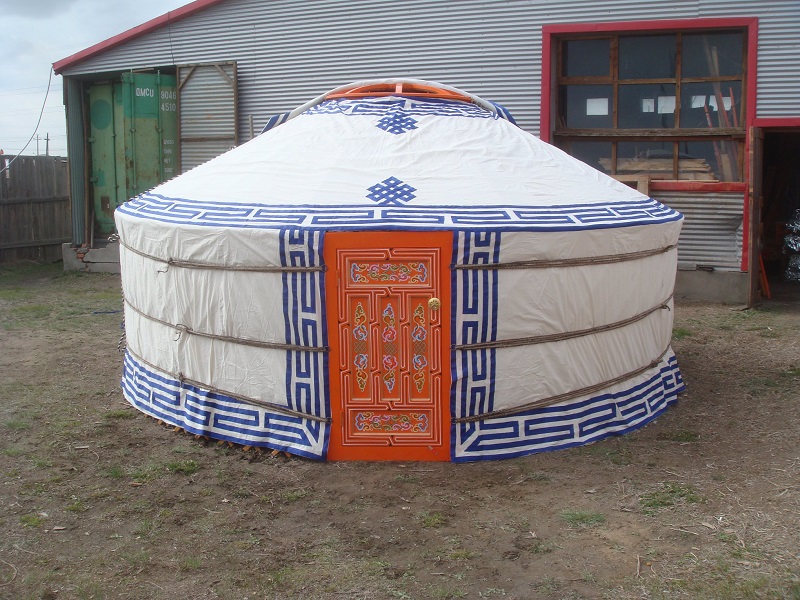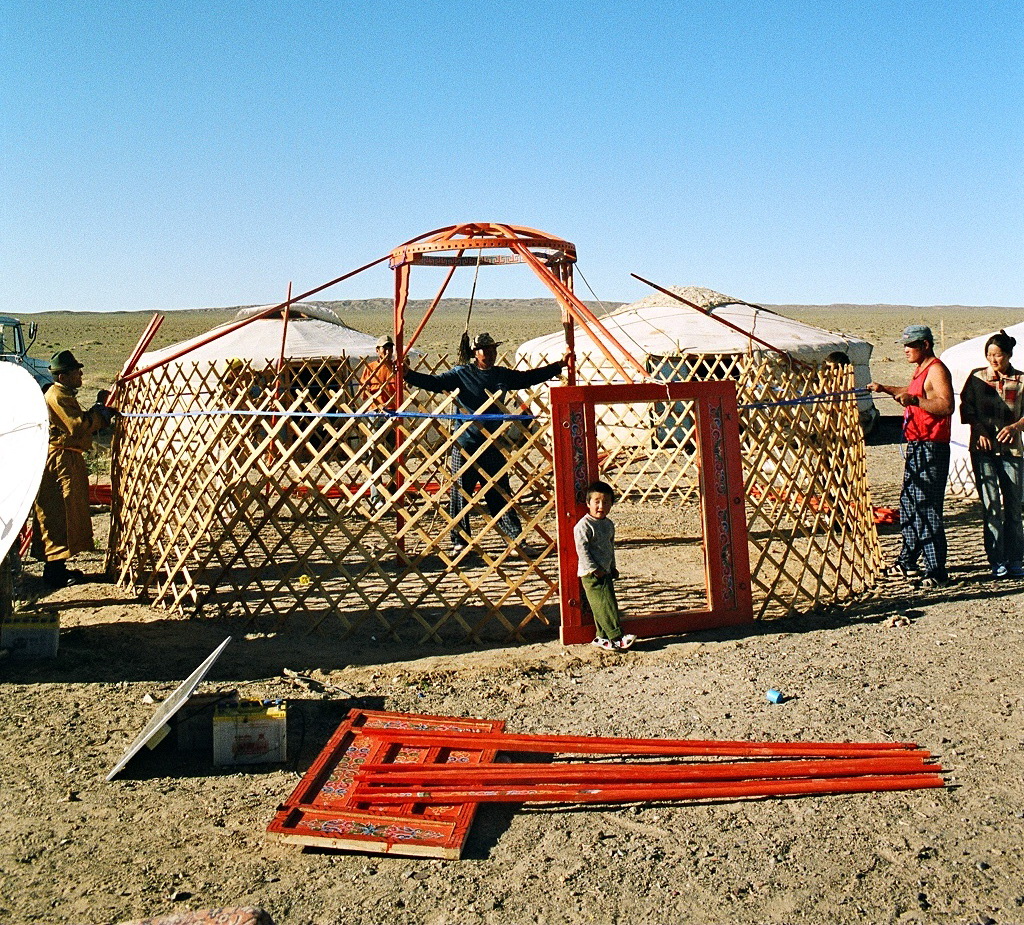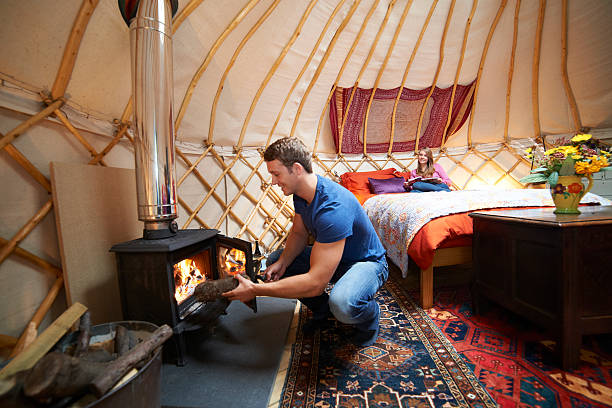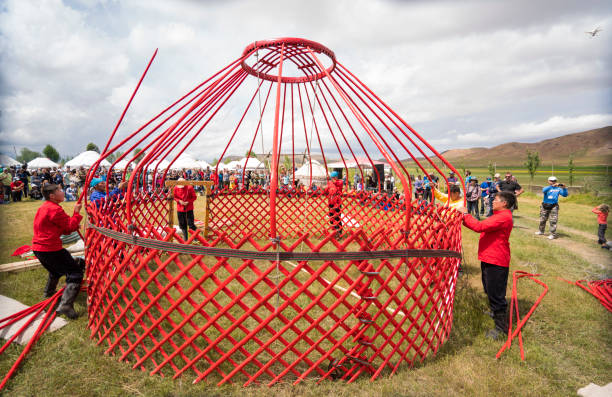The number of people purchasing Mongolian Ger / Yurt has been increasing both domestically and internationally. Ger is admired for its sturdy, unique structure and practical features by many. People have been living in Ger for the last three thousand years, yet still, it is one of the most practical, comfortable, and affordable type of housing. Nowadays, regardless of the purpose of use, Ger is one of the best investments you can make when it comes to cheap housing.
Buy Mongolian Yurt: https://silkroadmongolia.com/traditional-ger-yurt/
How Much Does it Cost Generally & Cost to Buy
The bigger the Ger is (the more khanas it has) the more expensive it is. So the price will increase according to size and they cost around anywhere between a few thousand dollars to tens of thousands of dollars. 3 wall panels start around 3000$ while 5 wall panels are usually sold for approximately 7000$. 6 wall panels are over 8000$ and 7 wall panels are over 12,000$. Gers with more than 10 khanas (walls) are priced at more than 22,000$. But keep in mind that these are average prices for Gers from Mongolia.
What Influences How Much Yurt Costs?

The total cost of a yurt varies greatly based on several factors. These include the size, the type of yurt, and whether you’re buying a yurt kit or building a yurt from scratch. Other factors like insulation, standard features, installation, and the cost to build a platform also significantly impact the final price.
Size of the Yurt
Just like traditional homes, the size of a yurt directly influences the price. Smaller yurts are naturally less expensive and can be a perfect fit for individuals or couples. However, larger yurts provide more space and comfort but come at a higher price. For instance, they can range anywhere from 12 to 30 feet in diameter, and the price typically increases with size.
Type and Material of the Yurt
They can come in a variety of types and materials, which impact the price tag. Traditional ones, often made from felt and canvas, are generally cheaper but might not offer the durability and comfort of modern yurts, which are constructed with durable materials like vinyl and polyester.
Insulation and Additional Features
If you plan on living in your yurt year-round, insulation is a crucial factor to consider. The cost of insulating a yurt can vary greatly depending on the type of material you choose.
In addition, additional features like glass windows, extra doors, customized flooring, or a specific type of roof can significantly add to the cost of a yurt. Moreover, don’t forget to consider the costs of any interior amenities you plan on adding, such as plumbing or electricity.
Yurt Installation and Platform
This is another factor that affects the cost. Some owners may choose to install their yurt themselves, while others may hire professionals, which will add to the bottom line. Furthermore, the platform – an essential base for your yurt – should also be taken into account.
Individual Seller VS Yurt Manufacturer
In Mongolia, people mostly buy Gers / Yurts from individual sellers rather than companies. It is because individual sellers offer much cheaper prices and there is usually room for negotiation/deal. Moreover, some people sell their Ger with the whole furniture for a low price. Buying everything in one place eases the process.
Nonetheless, if it is your first time purchasing or building a Ger, it is better to buy it from an official company. Most of the time, they offer a long-term guarantee and step-by-step guidance on building and even living in your Ger. So you will have a smooth process by getting help and guidance from experienced people while getting your desired results. However, you must also make sure to research to company: ask them questions you are curious about, check if their customer service is good, see their rating and reviews from previous customers, etc.
Delivery and Maintenance
Lastly, the delivery cost of delivering your yurt or yurt kit to your location, as well as ongoing maintenance costs, should be factored into the overall expense.
In summary, the cost of a yurt is influenced by many factors, making each yurt a unique investment. From size and type to additional features and installation, it’s essential to consider all these aspects when determining how much your dream yurt will cost.
Build a Yurt or Buy a DIY Yurt Kit?

When it comes to creating your own yurt build, you have two primary options: build a yurt from scratch or buy a DIY yurt kit. Both choices offer their own set of advantages and can influence the overall cost. Understanding the differences can help you make the best decision for your situation.
Building a Yurt from Scratch
Building a yurt from scratch offers a unique sense of accomplishment and allows for maximum customization. You have complete control over the materials, design, and layout, enabling you to construct a yurt that perfectly suits your needs.
However, this option requires a considerable amount of time, effort, and potentially, woodworking skills. You’ll need to source your materials, create or find designs, and devote significant labor hours to the project. While the raw material costs might be less, the additional labor costs (either your own time or hiring professionals) should be taken into account.
Buying a DIY Yurt Kit
On the other hand, buying kit provides a balance between DIY enthusiasm and convenience. These kits come with all the necessary parts and detailed instructions, simplifying the construction process. You’ll still have the pleasure of building your own yurt but without the stress of sourcing materials or designing the structure.
Yurt kits come in a range of sizes and styles, with options for customization. However, they might be more expensive upfront than building from scratch due to the cost of assembling the kit and the convenience provided.
But don’t forget, even with a yurt kit, you’ll need to prepare the land and build a platform, which is an additional cost to consider.
We in fact sell DIY Kits for very affordable prices, see our catalog: https://silkroadmongolia.com/traditional-ger-yurt/
Things to Keep in Mind About Owning a Yurt

Living in a yurt can be very different from residing in a conventional home. Yurts offer a closer connection to nature and often promote a simpler, less cluttered lifestyle. However, it’s crucial to remember that yurts can also come with their own set of challenges. For example, heating and cooling can be more complex in a yurt compared to a traditional house.
Site Selection and Preparation
Before you can set up your yurt, you will need to choose a suitable location and prepare the site adequately. This process includes creating a level platform, ensuring access to utilities if necessary, and considering factors like sunlight exposure, wind direction, and privacy. Site preparation can also involve additional costs that need to be factored into the overall budget.
Building Regulations and Permits
In some countries and cases, yurts may be subject to the same building codes and regulations as traditional houses. This could mean needing a permit to build your yurt or needing to adhere to specific construction standards. Check local regulations before purchasing your yurt to ensure you can legally and safely set it up.
Ongoing Maintenance
Yurts require regular maintenance to stay in top shape. This could include treating the exterior to remain waterproof, maintaining the structural integrity of the yurt, or updating insulation as needed. When considering yurt ownership, factor in the time and cost of ongoing maintenance.
Insulation and Heating
This is critical if you’re planning on living in your yurt year-round. While modern ones often come with pre-built options, they may need to be supplemented depending on your local climate. Similarly, heating options will need to be considered to keep your yurt cozy during colder months.
Plumbing and Water Systems
The actual installation of a plumbing system in a yurt can be more complicated than in a traditional house. Yurts have unique construction features, such as their circular shape and the use of a platform, which can pose challenges. However, with careful planning and the right professional help, plumbing can be installed in a yurt much like it would be in any other structure.
Remember, running water lines and waste pipes beneath the platform is usually the most practical solution, but these must be adequately insulated to prevent freezing in colder climates.
Off-Grid Solutions
For yurts located in remote areas or for owners interested in sustainable living, off-grid solutions may be suitable. These could include composting toilets, rainwater harvesting, and solar water heaters. Remember, these systems must comply with local regulations and be installed and maintained correctly to ensure safety and effectiveness.
Bathrooms and Kitchens
For the installation of bathrooms and kitchens in a yurt, you will likely need a septic system or connection to public sewer lines for wastewater. Keep in mind the placement of these areas relative to your water and sewer lines to minimize plumbing complexity.
Resale Value
If you plan to sell your yurt in the future, keep in mind that the resale market for yurts may be significantly less than that for traditional houses.
What are the best types of yurts?
The “best yurt” often depends on personal preference and intended use. There are a variety of yurt options. Modern ones, typically built with robust materials like vinyl or polyester, are more suited to those looking for comfort and longevity. They’re an ideal choice if you’re planning on living in a yurt year-round. Traditional ones, usually constructed from felt and canvas, offer a more authentic experience. Many yurt owners find a balance between tradition and modernity that suits their needs best. Yurts come in different sizes and selections.
What standard features are included in a yurt?
A standard yurt typically includes the circular structure, with a durable frame made from wood or metal, a canvas or vinyl cover, a door, and a central opening at the top of the yurt for ventilation and light. Many yurts also come with options for windows, insulation, and customized flooring. More luxurious yurts may have additional features like glass windows or custom-built doors.
How much does a yurt cost?
How much a yurt costs can vary greatly depending on size, materials, and additional features. A smaller yurt can cost anywhere from a few thousand dollars, while a luxury yurt, modern yurt, and larger yurt can run into tens of thousands. It’s essential to consider not only the price of your yurt but also the cost of site preparation, installation, and any additional features you want. Please contact us for a quote.
Cost to build a yurt?
If you’re building a yurt from scratch, the cost to build can vary depending on the materials used and the size. DIY yurts can be a cost-effective option, potentially saving thousands compared to buying a yurt kit or having a yurt custom-built. Keep in mind, building a yurt also includes the price of tools, site preparation, and potential labor costs if you’re hiring a professional. You can expect to build your own with a few thousand dollars.
How much does it cost for a yurt installation?
It costs can differ based on whether you opt to do it yourself or hire a professional. If you’re comfortable with DIY projects, you might save money, but hiring a professional can ensure a quick and correct setup. Installation can cost a few hundred to a couple of thousand dollars, depending on the complexity of the yurt and the local labor rates.
How much does a yurt platform cost?
The cost of a yurt platform varies based on the size, the type of materials used, and whether you build it yourself or hire a professional. A platform can cost anywhere from a few hundred dollars for a simple DIY project to several thousand for a large, professionally built yurt deck.
How do I solve insulation in a yurt build?
Insulation is crucial for a comfortable yurt living, especially if you plan on using your yurt year-round. Options for yurt insulation include traditional felt, modern synthetic materials, or even spray foam. Remember to insulate not only the walls but also the roof and floor for maximum efficiency.
Please give me a yurt cost breakdown example for a basic yurt
Let’s assume a basic yurt kit costs $5,000. Additional yurt construction costs might include:
– Platform construction: $1,000
– Insulation: $500
– Installation (if using professionals): $1,000
– Shipping/Delivery: $500
In this example, the average cost for a basic yurt would be around $8,000. Remember, these costs can vary widely based on your specific circumstances and choices.
Where can I buy a yurt and yurt accessories?
Several companies specialize in yurts and yurt accessories. Pacific Yurts is one of the most well-known yurt companies, but there are many others to consider, each with its unique offerings. Accessories, such as additional windows, custom doors, or specialized insulation, are typically available through the same company you buy your yurt from.
What’s it like living in a yurt?
Living in a yurt can be a unique, rewarding experience. Many yurt owners enjoy the connection to nature, the simplicity of the space, and the flexibility to customize their homes. However, yurt living also comes with challenges – from planning and installing utilities to dealing with weather conditions. Yurts can offer a wonderful balance between comfort and rustic living if you’re prepared for the unique challenges they present.
How long does a yurt last?
The lifespan of a yurt largely depends on the quality of its materials, the conditions in which it’s used, and the care taken in its maintenance. On average, modern ones with high-quality materials and proper care can last between 15 to 25 years, or even longer.
Traditional yurts, made of organic materials like felt and canvas, may not last as long due to the materials’ susceptibility to wear and tear from the elements. However, with diligent maintenance and care, a traditional yurt can also have a significant lifespan.
Remember, elements like the yurt’s cover, insulation, and wooden parts might require replacement or maintenance over time to prolong the yurt’s overall life. Regardless of the type, regular maintenance, and prompt repairs are crucial to ensuring that yurts can last for many years.

